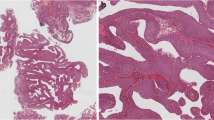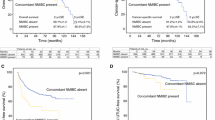Abstract
Purpose
To define the clinical and pathological patterns of urinary bladder carcinoma from the University Hospital of Nepal.
Methods
This is a retrospective analytical study. Patients with bladder mass who underwent surgery over 1 year and who had data record were included in the study. Demographic profile, type of surgery, findings on clinical examination, cystoscopy findings, histopathological report, tumor stage, and post-surgery adjuvant therapy were analyzed.
Results
Out of 86 patients who underwent transurethral resection of bladder tumor, 77 patients had biopsy-proven malignant bladder tumor. Urothelial cancer was present in 96.1%. Male were 78.6%. The mean age of diagnosis was 65.5 ± 11.8 years. Non-muscle-invasive bladder cancer (NMIBC) was 3.7 times more common than muscle-invasive bladder cancer (MIBC). High-grade tumors (58.6%) were more common than low grade (41.4%). The detrusor muscle was present inthe biopsy specimen of 48 patients (64%). Re-TURBT within 2–6 weeks was considered based on histopathology reports for about half of the patients (45.3%). Upstaging and upgrading of the tumor was present in 5.8 and 5.8% of the patients, respectively. Residual tumor without upstaging and upgrading was present in 23.5%. One patient (1.3%) had Clavien–Dindo grade 1, three (4%) patients had grade 2 and two patients (2.7%) had grade 3b.
Conclusion
In the present study, patients with bladder cancer are younger than reported in other studies. Smokers are strongly predisposed. The histological pattern is similar to the Western and Asian populations. NMIBC and MIBC occur in proportion to that described as in other studies. We had a lower rate of recurrence, upstaging and upgrading. We had a lesser rate of acceptance for radical cystectomy in our patients.
Similar content being viewed by others
References
Dy GW, Gore JL, Forouzanfar MH, Naghavi M, Fitzmaurice C (2017) Global burden of urologic cancers, 1990–2013. Eur Urol 71(3):437–446. https://pubmed.ncbi.nlm.nih.gov/28029399/
Bray F, Ren JS, Masuyer E, Ferlay J (2013) Global estimates of cancer prevalence for 27 sites in the adult population in 2008. Int J Cancer 132(5):1133–1145. https://pubmed.ncbi.nlm.nih.gov/22752881/
Cancer Facts & Figures (2020) American Cancer Society [Internet]. Cancer.org. 2021 [cited 12 June 2021]. Available from: https://www.cancer.org/research/cancer-facts-statistics/all-cancer-facts-figures/cancer-facts-figures-2020.html
Poudel KK, Huang Z, Neupane PR, Steel R, Poudel JK (2017) Hospital-based cancer incidence in Nepal from 2010 to 2013. Nepal J Epidemiol 7(1):659–665. https://pubmed.ncbi.nlm.nih.gov/28970948/
Dindo D, Demartines N, Clavien PA (2004) Classification of surgical complications: a new proposal with evaluation in a cohort of 6336 patients and results of a survey. Ann Surg 240(2):205–213. https://pubmed.ncbi.nlm.nih.gov/15273542/
WHO Classification of Tumours of the Urinary System and Male Genital Organs. 4th edn., vol 8. 2016. Moch H, Humphrey PA, Ulbright TM, Reuter VE (eds), Lyon, France. https://publications.iarc.fr/Book-And-Report-Series/Who-Classification-Of-Tumours/WHO-Classification-Of-Tumours-Of-The-Urinary-System-And-Male-Genital-Organs-2016
TNM classification of malignant tumors. UICC International Union Against Cancer. 8th edn., G.M. Brierley JD, Wittekind C (Eds). 2017, Wiley-Blackwell and UICC, New York, USA https://www.uicc.org/news/8th-edition-uicc-tnm-classification-malignant-tumors-published
Cancer Research UK (2017), Bladder cancer incidence statistics, Cancer Research UK. https://www.cancerresearchuk.org/health-professional/cancer-statistics/statistics-by-cancer-type/bladder-cancer/incidence
Lamm DL, Blumenstein BA, Crissman JD, Montie JE, Gottesman JE, Lowe BA, Sarosdy MF, Bohl RD, Grossman HB, Beck TM, Leimert JT, Crawford ED (2000) Maintenance bacillus Calmette-Guerin immunotherapy for recurrent TA, T1 and carcinoma in situ transitional cell carcinoma of the bladder: a randomized Southwest Oncology Group Study. J Urol 163(4):1124–1129. https://pubmed.ncbi.nlm.nih.gov/10737480/
Alishahi S, Byrne D, Goodman CM, Baxby K (2002) Haematuria investigation based on a standard protocol: emphasis on the diagnosis of urological malignancy. J R Coll Surg Edinb 47(1):422–427. https://pubmed.ncbi.nlm.nih.gov/11874263/
Edwards TJ, Dickinson AJ, Natale S, Gosling J, McGrath JS (2006) A prospective analysis of the diagnostic yield resulting from the attendance of 4020 patients at a protocol-driven haematuria clinic. BJU Int 97(2):301–305; discussion 305. https://pubmed.ncbi.nlm.nih.gov/16430634/
Aldousari S, Kassouf W (2010) Update on the management of non-muscle invasive bladder cancer. Can Urol Assoc J 4(1):56–64. https://pubmed.ncbi.nlm.nih.gov/20165581/
Ro JY, Staerkel GA, Ayala AG (1992) Cytologic and histologic features of superficial bladder cancer. Urol Clin North Am 19(3):435–453. https://pubmed.ncbi.nlm.nih.gov/1636229/
Sylvester RJ, van der Meijden A, Witjes JA, Jakse G, Nonomura N, Cheng C, Torres A, Watson R, Kurth KH (2005) High-grade Ta urothelial carcinoma and carcinoma in situ of the bladder. Urology 66(6 Suppl 1):90–107. https://pubmed.ncbi.nlm.nih.gov/16399418/
Joshi HN, Makaju R, Karmacharya A, Karmacharya RM, Shrestha B, Shrestha R, de Jong IJ, Shrestha RK (2013) Urinary bladder carcinoma: impact of smoking, age and its clinico-pathological spectrum. Kathmandu Univ Med J (KUMJ) 11(44):292–295. https://pubmed.ncbi.nlm.nih.gov/24899322/
Goyal B, Rao S, Sahi R, Jaiswal S (2018) A histopathologic study of urinary bladder tumors at tertiary care center in Mid-Western region of Nepal. Asian J Med Sci 9(6):45–50. https://www.nepjol.info/index.php/AJMS/article/view/20685
Chinnasamy R, Krishnamoorthy S, Joseph L, Kumaresan N, Ramanan V (2016) Clinico-pathological study of bladder cancer in a tertiary care center of south india and impact of age, gender, and tobacco in causing bladder cancer: a single center experience. Int J Sci Study 3(10):72–77. http://www.ijss-sn.com/uploads/2/0/1/5/20153321/ijss_jan_oa15.pdf
Mariappan P, Zachou A, Grigor KM, Edinburgh Uro-Oncology Group (2010) Detrusor muscle in the first, apparently complete transurethral resection of bladder tumour specimen is a surrogate marker of resection quality, predicts risk of early recurrence, and is dependent on operator experience. Eur Urol 57(5):843–849. https://pubmed.ncbi.nlm.nih.gov/19524354/
Babjuk M, Böhle A, Burger M, Capoun O, Cohen D, Compérat EM, Hernández V, Kaasinen E, Palou J, Rouprêt M, van Rhijn BWG, Shariat SF, Soukup V, Sylvester RJ, Zigeuner R (2017) EAU guidelines on non-muscle-invasive urothelial carcinoma of the bladder: update 2016. Eur Urol 71(3):447–461. https://pubmed.ncbi.nlm.nih.gov/27324428/
Chang SS, Boorjian SA, Chou R, Clark PE, Daneshmand S, Konety BR, Pruthi R, Quale DZ, Ritch CR, Seigne JD, Skinner EC, Smith ND, McKiernan JM (2016) Diagnosis and treatment of non-muscle invasive bladder cancer: AUA/SUO guideline. J Urol 196(4):1021–1029. https://pubmed.ncbi.nlm.nih.gov/27317986/
Gendy R, Delprado W, Brenner P, Brooks A, Coombes G, Cozzi P, Nash P, Patel MI (2016) Repeat transurethral resection for non-muscle-invasive bladder cancer: a contemporary series. BJU Int 117 Suppl 4:54–59. https://pubmed.ncbi.nlm.nih.gov/26486968/
Sountoulides P, Mutomba WF, Bouras E, Lim J, Bourdoumis A, Jain A (2020) How well do we manage non-muscle invasive bladder tumors? A UK audit of real-life practices. Urologia 87(3):142–148. https://pubmed.ncbi.nlm.nih.gov/31959070/
Grimm MO, Steinhoff C, Simon X, Spiegelhalder P, Ackermann R, Vogeli TA (2003) Effect of routine repeat transurethral resection for superficial bladder cancer: a long-term observational study. J Urol 170(2 Pt 1):433–437. https://pubmed.ncbi.nlm.nih.gov/12853793/
Gordon PC, Thomas F, Noon AP, Rosario DJ, Catto JWF (2019) Long-term outcomes from re-resection for high-risk non-muscle-invasive bladder cancer: a potential to rationalize use. Eur Urol Focus 5(4):650–657. https://pubmed.ncbi.nlm.nih.gov/29089252/
Baltacı S, Bozlu M, Yıldırım A, Gökçe Mİ, Tinay İ, Aslan G, Can C, Türkeri L, Kuyumcuoğlu U, Mungan A (2015) Significance of the interval between first and second transurethral resection on recurrence and progression rates in patients with high-risk non-muscle-invasive bladder cancer treated with maintenance intravesical Bacillus Calmette-Guérin. BJU Int 116(5):721–726. https://pubmed.ncbi.nlm.nih.gov/25715815/
Miladi M, Peyromaure M, Zerbib M, Saïghi D, Debré B (2003) The value of a second transurethral resection in evaluating patients with bladder tumours. Eur Urol 43(3):241–245. https://pubmed.ncbi.nlm.nih.gov/12600426/
Herr HW (2015) Role of repeat resection in non-muscle-invasive bladder cancer. J Natl Compr Canc Netw 13(8):1041–1046. https://pubmed.ncbi.nlm.nih.gov/26285248/
Shukla SK, Chandra S, Chauhan N, Sarpal R (2021) Expression of CD10 in urothelial carcinoma of the bladder and its correlation with histopathological grade, pathological stage, and survival of patients. J Can Res Ther [Epub ahead of print]
Bahadir B, Behzatoglu K, Bektas S, Bozkurt ER, Ozdamar SO (2009) CD10 expression in urothelial carcinoma of the bladder. Diagn Pathol 4:38. https://pubmed.ncbi.nlm.nih.gov/19917108/
Sylvester RJ, Oosterlinck W, Holmang S, Sydes MR, Birtle A, Gudjonsson S, De Nunzio C, Okamura K, Kaasinen E, Solsona E, Ali-El-Dein B, Tatar CA, Inman BA, N'Dow J, Oddens JR, Babjuk M (2016) Systematic review and individual patient data meta-analysis of randomized trials comparing a single immediate instillation of chemotherapy after transurethral resection with transurethral resection alone in patients with stage pTa-pT1 urothelial carcinoma of the bladder: which patients benefit from the instillation? Eur Urol 69(2):231–244. https://pubmed.ncbi.nlm.nih.gov/26091833/
Comploj E, Dechet CB, Mian M, Trenti E, Palermo S, Lodde M, Mian C, Ambrosini-Spaltro A, Horninger W, Pycha A (2014) Perforation during TUR of bladder tumours influences the natural history of superficial bladder cancer. World J Urol 32(5):1219–1223. https://pubmed.ncbi.nlm.nih.gov/24166290/
O'Donnell MA (2005) Practical applications of intravesical chemotherapy and immunotherapy in high-risk patients with superficial bladder cancer. Urol Clin North Am 32(2):121–131. https://pubmed.ncbi.nlm.nih.gov/15862610/
Author information
Authors and Affiliations
Corresponding author
Additional information
Publisher's Note
Springer Nature remains neutral with regard to jurisdictional claims in published maps and institutional affiliations.
Rights and permissions
About this article
Cite this article
Parajuli, P., Luitel, B.R., Pradhan, M.M. et al. Clinicopathological patterns of bladder carcinoma over 1 year: experience from University Hospital of Nepal. Int Urol Nephrol 53, 2289–2294 (2021). https://doi.org/10.1007/s11255-021-02969-6
Received:
Accepted:
Published:
Issue Date:
DOI: https://doi.org/10.1007/s11255-021-02969-6




